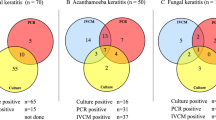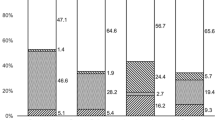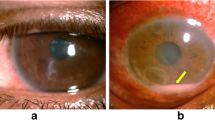Abstract
Purpose
To determine the usefulness of smears in the diagnosis of infectious keratitis by comparing smears and 2 different culture methods.
Study design
Retrospective, observational study.
Methods
The foci of 73 patients diagnosed with infectious keratitis at Hiroshima University Hospital between July 2011 and September 2015 were abraded, and smear microscopy and culturing were performed. The microorganism detection rates and other parameters were compared.
Results
Microorganisms were detected in 47 of 73 specimens. Microorganisms were identified in 32 of 69 cases cultured on plain medium (detection rate, 46.4%) compared with 22 of 61 cases cultured on swab transport medium (detection rate, 36.1%). There was no significant difference in the microbial detection rate between the plain medium method and the swab transport medium method (P = 0.23). Smear microscopy and culture findings were concordant in 21 (28.8%) cases, and different microorganisms were detected in 9 cases. In 17 cases, the culture was negative, despite the presence of microorganisms on smear microscopy, and in 7 cases, the culture was positive, despite the absence of microorganisms on smear microscopy. The positivity rate of microbial detection was significantly higher when no antimicrobial agents had been administered previously (odds ratio 7.50, P = 0.017).
Conclusion
Smear microscopy of abrasions from lesions is useful for the initiation of treatment for infectious keratitis. However, culture studies should be conducted at the same time to confirm antimicrobial sensitivity. If possible, smear microscopy should be performed before the initiation of antimicrobial therapy.





Similar content being viewed by others
References
Hatano H, Inoue K, Ohashi Y, Shimomura Y, Sakamoto M, Okamoto Y. Drug sensitivity of causative agents in ocular infection of external adnexa and anterior segments—multicenter study of causative agents and drug sensitivity of ocular infection by the Japanese association for ocular infection part II. Nippon Ganka Gakkai Zasshi. 2011;115:814–24 (in Japanese).
Moshirfar M, Hopping GC, Vaidyanathan U, Liu H, Somani AN, Ronquillo YC, et al. Biological staining and culturing in infectious keratitis: controversy in clinical utility. Med Hypothesis Discov Innov Ophthalmol. 2019;8:145–51.
McLeod SD, Kolahdouz-Isfahani A, Rostamian K, Flowers CW, Lee PP, McDonnell PJ. The role of smears, cultures, and antibiotic sensitivity testing in the management of suspected infectious keratitis. Ophthalmology. 1996;103:23–8.
Kudo J, Hatano H, Kurita M, Ohno S. Comparison of smear and culture techniques. Nihon Ganka Kiyo. 1995;46:1231–3 (in Japanese).
Nakabayashi J, Mikawa Y, Okinami S. Infectious corneal ulcer cases in the past 10 years at Saga medical school hospital. Nihon Ganka Kiyo. 2002;53:368–72 (in Japanese).
Hernandez-Camarena JC, Graue-Hernandez EO, Ortiz-Casas M, Ramirez-Miranda A, Navas A, Pedro-Aguilar L, et al. Trends in microbiological and antibiotic sensitivity patterns in infectious keratitis: 10-year experience in Mexico city. Cornea. 2015;34:778–85.
Chang-Sotomayor M, Llorens Belles V, Latasiewicz M, Torras-Sanvicens J, Blanco-Dominguez I, Sabater-Cruz N, et al. Comparison of two methods for obtaining and transporting corneal samples in suspected infectious keratitis. J Fr Ophthalmol. 2020;43:477–83.
Pakzad-Vaezi K, Levasseur SD, Schendel S, Mark S, Mathias R, Roscoe D, et al. The corneal ulcer one-touch study: a simplified microbiological specimen collection method. Am J Ophthalmol. 2015;159:37–43.
Aruljyothi L, Radhakrishnan N, Prajna VN, Lalitha P. Clinical and microbiological study of paediatric infectious keratitis in South India: a 3-year study(2011–2013). Br J Ophthalmol. 2016;100:1719–23.
Sharma S, Taneja M, Gupta R, Upponi A, Gopinathan U, Nutheti R, et al. Comparison of clinical and microbiological profiles in smear-positive and smear-negative cases of suspected microbial keratitis. Indian J Ophthalmol. 2007;55:21–5.
Shimizu D, Miyazaki D, Ehara F, Shimizu Y, Uotani R, Inata K. Effectiveness of 16S ribosomal DNA real-time PCR and sequencing for diagnosing bacterial keratitis. Graefe’s Arch Clin Exp Ophthalmol. 2020;258:157–66.
Khor WB, Prajna VN, Garg P, Mehta JS, Xie L, Liu Z, et al. The asia cornea society infectious keratitis study: a prospective multicenter study of infectious keratitis in asia. Am J Ophthalmol. 2018;195:161–70.
Study Group of National Surveillance of Infectious Keratitis in Japan. National surveillance of infectious keratitis in Japan. Nippon Ganka Gakkai Zasshi. 2006;110:961–72. (in Japanese)
Sharma S, Kunimoto DY, Gopinathan U, Athmanathan S, Garg P, Rao GN. Evaluation of corneal scraping smear examination methods in the diagnosis of bacterial and fungal keratitis: a survey of eight years of laboratory experience. Cornea. 2002;21:643–7.
Kiehlbauch JA, Hannett GE, Salfinger M, Archinal W, Monserrat C, Carlyn C. Use of the national committee for clinical laboratory standards guidelines for disc diffusion susceptibility testing in New York state laboratories. J Clin Microbiol. 2000;38:3341–8.
Austin A, Lietman T, Rose-Nussbaumer J. Update on the management of infectious keratitis. Ophthalmology. 2017;124:1678–89.
Nakano S, Tomaru Y, Kubota T, Takase H, Mochizuki M, Shimizu N, et al. Evaluation of a multiplex strip PCR test for infectious uveitis:a prospective multicenter study. Am J Ophthalmol. 2020;213:252–9.
Nakano S, Sugita S, Tomaru Y, Hono A, Nakamuro T, Kubota T, et al. Establishment of multiplex solid-phase strip PCR test for detection of 24 ocular infectious disease pathogens. Invest Ophthalmol Vis Sci. 2017;58:1553–9.
Somerville TF, Corless CE, Sueke H, Neal T, Kaye SB. 16s ribosomal RNA versus conventional diagnostic culture in the investigation of suspected bacterial keratitis. Transl Vis Sci Technol. 2020;9:2.
Acknowledgements
We thank Edanz (https://jp.edanz.com/ac) for editing a draft of this manuscript.
Author information
Authors and Affiliations
Corresponding author
Ethics declarations
Conflicts of interest
K. Mitoma, None; T. Chikama, None; R. Toda, None; Y. Yuasa, None; Y. Kiuchi, None.
Additional information
Publisher's Note
Springer Nature remains neutral with regard to jurisdictional claims in published maps and institutional affiliations.
Corresponding Author: Kaori Mitoma
About this article
Cite this article
Mitoma, K., Chikama, Ti., Toda, R. et al. Usefulness of smear microscopy for therapeutic decision-making in patients with infectious keratitis. Jpn J Ophthalmol 67, 570–577 (2023). https://doi.org/10.1007/s10384-023-01011-9
Received:
Accepted:
Published:
Issue Date:
DOI: https://doi.org/10.1007/s10384-023-01011-9




